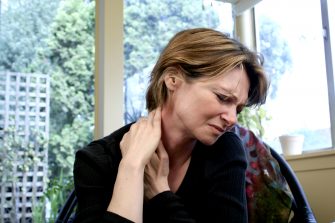Research Shows Both Dry Needling and Manual Pressure Technique Provide Effective Pain Relief
 One of the most common musculoskeletal complaints is neck/shoulder pain. While it affects 45%-54% of the general population, it tends to be more frequent in women. Myofascial pain is diagnosed when patient has a section of skeletal muscle fibers that is overly irritable. This can result in pain when the patient moves, stretches, or if the muscle tissue is compressed. Patients may report pain, muscle weakness or reduced range of motion. These symptoms can have a significant effect on a patient’s daily activities and overall health.
One of the most common musculoskeletal complaints is neck/shoulder pain. While it affects 45%-54% of the general population, it tends to be more frequent in women. Myofascial pain is diagnosed when patient has a section of skeletal muscle fibers that is overly irritable. This can result in pain when the patient moves, stretches, or if the muscle tissue is compressed. Patients may report pain, muscle weakness or reduced range of motion. These symptoms can have a significant effect on a patient’s daily activities and overall health.
Much of the previous research has focused on either manual pressure or dry needling as compared to a placebo or other treatment techniques. Overall, these studies revealed “a decrease in pain intensity, a higher pressure pain threshold (PPT), improvement in functionality, increase in range of motion, reduction of stiffness, and improvement of muscle strength” after either manual therapy or dry needling. There was little information on long term effect or comparing these two treatments.
In the recent issue of Journal of Manipulative and Physiological Therapeutics, a study entitled, “Comparing Trigger Point Dry Needling and Manual Pressure Technique for the Management of Myofascial Neck/Shoulder Pain: A Randomized Clinical Trial” sheds new light on this subject.
Researchers in Belgium set out to determine if one of these treatments was more effective than the other at reducing pain intensity, reducing disability and improving muscle characteristics, as well as evaluating the long term results.
For this clinical trial, 42 female office workers reporting myofascial neck/shoulder pain were randomly assigned to 2 groups – dry needling and myofascial pressure. Each subject was evaluated, given 4 treatments over 4 weeks, re-evaluated, then re-evaluated again after 3 months.
Treatment of myofascial pain with manual pressure involves the application of increasing pressure directly on the muscle fibers by the therapist. Dry needling treatment involves the therapist inserting a solid needle to the muscle tissue.
Researchers found no significant difference between the 2 groups. At the conclusion of the treatment, subjects in both groups reported significant improvement in the Neck Disability Index, the numerical rating scale, pain pressure threshold, muscle elasticity, and stiffness. Additionally, the improvements in Neck Disability Index, and the numerical rating scale persisted at the 3 month post treatment evaluation.
This study is one of only a few to compare dry needling with manual pressure, two common myofascial release techniques commonly used in clinical practice. This study focused on myofascial neck/shoulder pain. These muscles are easily accessible for both techniques. Therefore, additional research is needed to further examine if these techniques continue similar results on other muscle groups. For now, this study is important in that it demonstrates the comparable efficacy of manual pressure and dry needling.
Source: Comparing Trigger Point Dry Needling and Manual Pressure Technique for the Management of Myofascial Neck/Shoulder Pain: A Randomized Clinical Trial
http://www.jmptonline.org/article/S0161-4754(16)30255-X/fulltext